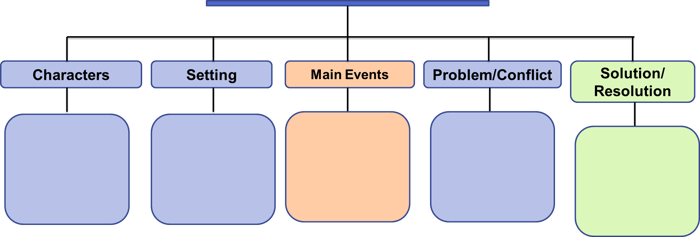Why Teaching Fiction Matters
Teaching fiction is an important endeavor in elementary school that can support students in meeting complex comprehension standards. This article shares the perspective of an educator and district curriculum specialist on the importance of teaching fiction. Learn how to use engaging fiction texts as a doorway to teach students important and transferable skills. Teaching how to navigate fictional text effectively in the classroom will allow students to practice their comprehension of fictional story structures in any environment.
Increasing Reading Volume
Research tells us that reading proficiency is highly correlated with the amount of reading that students do. More reading results in higher reading achievement, and higher achievement in reading leads students to even more reading and more learning.
 One way to increase students’ reading volume is to provide them with reading materials that they find interesting, that represent varied genres, and that allow students to connect to the events in the stories. Fiction texts are highly engaging to students. The first step in this process is ensuring students have access to fictional texts with the following attributes:
One way to increase students’ reading volume is to provide them with reading materials that they find interesting, that represent varied genres, and that allow students to connect to the events in the stories. Fiction texts are highly engaging to students. The first step in this process is ensuring students have access to fictional texts with the following attributes:
- diverse characters
- engaging stories
- cross-curricular content connections
- attention-grabbing covers and illustrations
For students, fiction is everywhere: in the classroom, in the library, on the television, on their devices. As a teacher, I wanted my students to engage with the readers I was using for small-group instruction in the same way they engaged with books from the school library and retail bookstores. The attributes above are what I used as criteria for choosing texts for teaching fiction in my classrooms.
After the fictional texts were selected, my colleagues and I could focus on two very important elements of any literature lesson: story structure and close reading.
Recognizing Story Structure
Teaching students to recognize the structure of stories in the classroom lays the foundation for developing more complex reading comprehension skills. This is a top recommendation for any teacher wanting to simplify the more complex literature standards we are tasked with teaching yearly.
If you have ever taught students how to determine the theme of a story or even summarize an entire story, you know how difficult it can be for students to respond correctly if they lack a basic understanding of the story.
In the grades that I taught and in the schools that I worked with, we tackled story structure of fiction texts before moving on to complex literature standards. The focus was simple. In grades K–2, students were taught to identify the characters, setting, events, problem, and solution within a story. In grades 3–5, they were taught to identify the main and secondary characters, setting(s), main events, conflict, and resolution of the fictional stories they read. This happened with plenty of modeling at the beginning of each school year, but I found that it made my life, and the lives of my teachers, much easier throughout the year.
 With this foundation, we were then able to move swiftly through skills like determining the theme of a story, making inferences, and summarizing stories.
With this foundation, we were then able to move swiftly through skills like determining the theme of a story, making inferences, and summarizing stories.
Close Reading
Close reading is another powerful way to explore fictional text. This is not the same as rereading. Instead, in close reading, students dive into a small component of the text. They use the mechanics of the text—sentence structure, word choice, language features—to deeply comprehend the author’s work. Close reading allowed my students to read for a purpose, a task not easily transferable to nonfiction text.
By returning to a short text or a small excerpt from a longer text, my students were able to dig deep to reveal layers of meaning created by the author. A few of the more common questions that were asked of my students during this time were:
- What is the author telling me?
- Are there any hard or important words?
- What does the author want me to understand?
- How does the author play with language to add to meaning?
This time with my students also allowed me to teach a very important skill, also transferable to more types of texts: annotating. When students learn how to annotate text, the likelihood that they will return to those annotations increases. I always found that the most difficult part of my literacy block was getting my students to go back into the story or text to find an answer to a question. While I still don’t have a magic answer for how to get all students to complete this task that seems easy to us educators, I can say that requiring my students to annotate the text with close reading strategies helped.
Involving Parents and Caregivers
Research also tells us the importance of involving parents and families in students’ reading development. All the practice suggested in this article can easily be used in the home.
I found limited success with assigning students a nightly reading log, an assignment that asked them to read for 20–30 minutes, compose a few sentences about what they read, and have a parent or caregiver sign. Most of my students completed this assignment on the bus ride to school and had a classmate sign. Instead, to ensure that students were engaging with meaningful reading each night, I assigned them a graphic organizer to complete. During parent conferences, I found that graphic organizers, like the example shown, supported discussion at the home and made the work purposeful.
 Teaching fiction is an excellent and important way to lay the foundation for skills that can be applied within and beyond the genre including recognizing story structure, close reading, and building comprehension skills. Teaching fiction can also help boost students’ reading volume and build home-school connections around reading.
Teaching fiction is an excellent and important way to lay the foundation for skills that can be applied within and beyond the genre including recognizing story structure, close reading, and building comprehension skills. Teaching fiction can also help boost students’ reading volume and build home-school connections around reading.
Author Bio:
View All AuthorsAlan Becker, Education Consultant
Alan Becker is TCM's Regional Vice President of the Northeast sales team. Prior to his current role, he worked as an Academic Officer for TCM, specializing in best practices for curriculum and instruction. He provided professional development and training in the content areas of math, ELA, and social studies using TCM curriculum materials and Shell Education professional resources for school districts, teachers, and educational trainers. Before joining TCM, Mr. Becker served as a District...
Join the TCM Blog Community
Subscribe by sharing your email address and we will share new posts, helpful resources and special offers on the issues and topics that matter to you and the children and teens you support.
